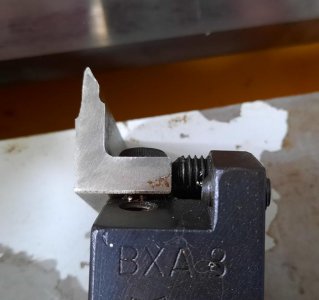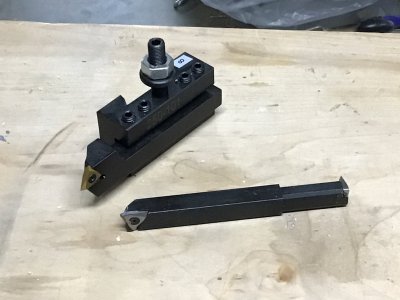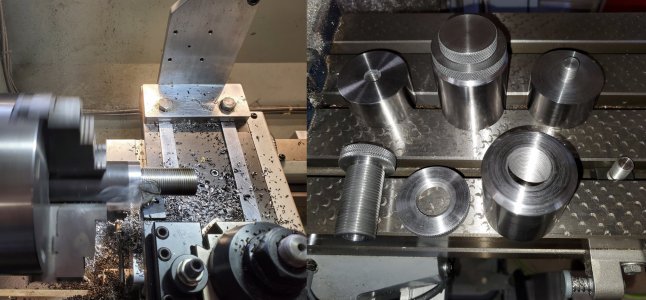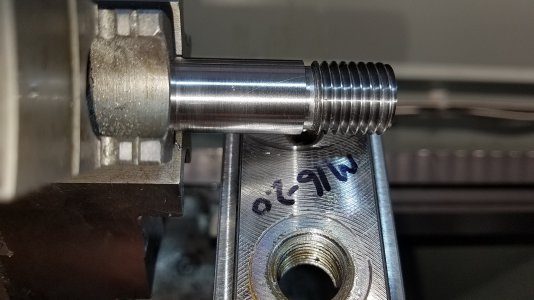Well, people are telling me carbide requires faster RPM, which is why I was using 200. And I would like as clean of a cut as I can get. I figure I can set my compound or set my cross-slide, lock them down at the left side and engage the half-nut with the lathe off, then turn on the lathe at any speed and let it cut as fast as it needs to from left to right; rinse and repeat...No need to be running at 200rpm unless the material requires it for finish/apperance.
A good cutting oil will help with surface finish, maybe even something sulpherated or a SS cutting oil.
Turning the tooling upside down will take the stress off of you, if your tooling can reach.
One thing I can’t stress enough is to be deliberate and methodical with threading. Lots of available handles and thoughts going through your head to screw up your work.
I still screw it up, but usually my stuff is a one off where worst thing is I need to start over.
These were fun. A punch holder and stripper for a machine long out of production.
View attachment 477030
-
Welcome back Guest! Did you know you can mentor other members here at H-M? If not, please check out our Relaunch of Hobby Machinist Mentoring Program!
You are using an out of date browser. It may not display this or other websites correctly.
You should upgrade or use an alternative browser.
You should upgrade or use an alternative browser.
Cut my first barrel tenon threads today.
- Thread starter TonyBen
- Start date
- Joined
- May 7, 2023
- Messages
- 1,385
Honestly, if the job doesn’t require carbide, I wouldn’t use it. 200 going towards the headstock is about the limit of my comfort zone.Well, people are telling me carbide requires faster RPM, which is why I was using 200. And I would like as clean of a cut as I can get. I figure I can set my compound or set my cross-slide, lock them down at the left side and engage the half-nut with the lathe off, then turn on the lathe at any speed and let it cut as fast as it needs to from left to right; rinse and repeat...
You have it, you’re going to use it, I get that, and on that machine you’re probably fine for gun smithing sized stuff.
It’s just that you’re going to need more tool pressure and that will require more cleanup cuts and throw another variable in the mix.
You will get it with more practice, just keep at it.
If you thread in reverse, you will probably want a left hand tool so that it can get close to a shoulder when you flip it over, however the tool you have will work fine for trying that out. I thread in reverse, and also made the proximity stop Mark Jacobs developed. For either of those methods, you can go faster than 200 rpm without worry, I have done 400+ rpm range for threading and it worked well. The only limitation is making sure you can consistently engage on the proper number on your thread dial, so I would practice at slower speeds and increase as you get more proficient. You will need a VFD on your lathe to use the proximity stop, so if you are single phase, reversing is a great method to use. The only reason I would thread slow is if I need to stop quickly, but that is not a concern by threading in reverse.
I mostly do metric, so when reversing the spindle direction to go back to the starting point, you do need to be careful not to hit the shoulder, but that is where the jog button comes in handy, get it close at the higher speed, and then use the jog for the last little bit. For imperial threads, you can put in a hard carriage stop where you want your starting point to be and then just manually move it back to the stop and then engage the threading lever again on the proper number, no reason to shut it off.
RBW is correct that you don’t need carbide for threading, it is nice to have, but HSS works just as well, just at a slower speed. If you are buying a new tool for reverse direction threading, take a look at the Aloris #8 tool, it is a HSS blade and holder that can be used for forward or reverse threading. If I knew that existed before I bought my tools, I probably would have gone with that.
I mostly do metric, so when reversing the spindle direction to go back to the starting point, you do need to be careful not to hit the shoulder, but that is where the jog button comes in handy, get it close at the higher speed, and then use the jog for the last little bit. For imperial threads, you can put in a hard carriage stop where you want your starting point to be and then just manually move it back to the stop and then engage the threading lever again on the proper number, no reason to shut it off.
RBW is correct that you don’t need carbide for threading, it is nice to have, but HSS works just as well, just at a slower speed. If you are buying a new tool for reverse direction threading, take a look at the Aloris #8 tool, it is a HSS blade and holder that can be used for forward or reverse threading. If I knew that existed before I bought my tools, I probably would have gone with that.
Oatley's is one example, yes. You can also get Rigid, Relton or Ace has some. Some folks swear by a particular brand, I've never seen much difference between them.Is this the same stuff as the Oatley's that was mentioned in the above post, or is it something else?
Also, I'm going to try inserting my thread holder upside down so I can thread from left to right with the lathe in reverse. What speed should I use with my carbide Top Notch insert?
I don't have a Top Notch, but I've used Shars threading inserts and gone as slow as my lathe would go, with good results. As long as the insert is sharp it'll work fine, and most, if not all, the threading inserts I've seen appear to be ground, so they don't take any more pressure than HSS (which I also use, and used to use exclusively). Best I can suggest is just keep testing. If the finish is good, then so is your speed.
Some people seem willing to stand on their head to avoid conventional threading, but with a little practice you won't have to go through any special contortions - it'll be just another tool in your toolpost. But I get it. I'm used to mess up internal threads, because I don't cut them often and my cross-slide hand wants to move the compound toward me at the end of a thread...
BTW, I never mess up the levers, because I keep one hand on the half-nut lever from the time I engage it until it's disengaged. My other hand is on the cross-slide dial so I can retract at the end of a cut. Both hands remain in place during the cut. Yes, I'm hunched (I'm 6'3" and my lathe is no taller than normal), but it's not for a very long at a time.
GsT
I have an Aloris #8, but thought it was too thick for threading in either direction. I thinned the flank on mine just to be able to get a bit closer to a shoulder.

If you want an HSS insert, I'd suggest looking at A.R. Warner, but there's absolutely value in learning how to grind one from a tool blank as well. Particularly in gunsmithing where there's a lot of improvisation happening all the time.
GsT

If you want an HSS insert, I'd suggest looking at A.R. Warner, but there's absolutely value in learning how to grind one from a tool blank as well. Particularly in gunsmithing where there's a lot of improvisation happening all the time.
GsT
I have the AR Warner threading tool, I got it probably 15 years ago and I’m still on the first insert. The nice thing about that is the toolholder also can thread internally with the opposite end. You can get inserts for it from Little Machine Shop or McMaster-Carr.
I bought a Mesa gooseneck tool for threading away from the chuck. It uses the same style insert as the AR Warner. It came with a carbide insert that so far is working well, but I’ve only had it a year. Much cheaper to get one of these than the Top Notch that I looked at first.

I bought a Mesa gooseneck tool for threading away from the chuck. It uses the same style insert as the AR Warner. It came with a carbide insert that so far is working well, but I’ve only had it a year. Much cheaper to get one of these than the Top Notch that I looked at first.

- Joined
- Jun 12, 2014
- Messages
- 4,817
No reason not to use carbide inserts, I do not see a reason to change. I have been using laydown carbide threading inserts (Carmex) for years, they cut just fine at different SFM's. I had very poor threading success with the vertical TNMC type when using carbide inserts, they wouldn't last. The Kennametal Top Notch type are suppose to work quite well. Threading is all about what works on your lathe and technique, I would practice a bit more and find what works best for you. When I had my 1340GT, as well as my current lathe, I just used the cross slide to advance the cutter, never had an issue and it also maintains the same cutter position when advancing. Since I use an electronic stopping system, I can thread upwards of 700 RPM, but for steel I typically thread around 250-300 RPM, mostly because I am often threading very course threads. Recheck that the cutting tip is on center or maybe a thousandth below.
All these threads were cut with a carbide laydown inserts.


All these threads were cut with a carbide laydown inserts.


I had a Savage take-off barrel that I've used before for chamber cutting practice and I used the muzzle end to practice some 5/8-24 threads. These came out much better than my receiver threads.
I flipped my cutter over and threaded from left to right with the lathe in reverse. Everything came out really nice and I polished up the threads with a needle file, scotch brite and a wire brush. The tops of the thread had some burrs so I skimmed the top of the threads with my turning bit. My barrel thread protector fit on very smooth and not too loose. I haven't gauged the threads yet but they should be in spec.






Tony.
I flipped my cutter over and threaded from left to right with the lathe in reverse. Everything came out really nice and I polished up the threads with a needle file, scotch brite and a wire brush. The tops of the thread had some burrs so I skimmed the top of the threads with my turning bit. My barrel thread protector fit on very smooth and not too loose. I haven't gauged the threads yet but they should be in spec.






Tony.
Those look good. Got to like how pretty barrel steel machines.
I use a 93 deg lead vcmt for the thread relief. .045" relief groove width is normally what I shoot for. The vcmt leaves a nice chamfer into the relief groove. Plus it leaves a nice finish and I can hit diameter fairly easy by leaving. 02" when I rough. The more you practice the easier it gets.
I use a 93 deg lead vcmt for the thread relief. .045" relief groove width is normally what I shoot for. The vcmt leaves a nice chamfer into the relief groove. Plus it leaves a nice finish and I can hit diameter fairly easy by leaving. 02" when I rough. The more you practice the easier it gets.
Looking good! Cratex makes some abrasive rubber 'sticks' that are great for cleaning up threads. I mostly just use the course (dark green). I'd slide that barrel into the chuck a bit. Looks like everything worked out, but that's a lot of stickout unless you used tailstock support.
GsT
GsT

